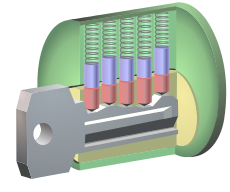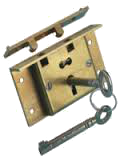Locks, Bolts and Catches
From DT Online
Description
Locks, Bolts and Catches for doors and drawers are available in many different shapes and styles to suite a wide range of applications and security requirements.
Locks are mechanical devices used to secure doors, drawers and lids for example. Most comprise a Key-operated mechanism which causes a bolt (i.e. a Dead Bolt) to protrude into a recess in the door frame (via a Strike Plate) or a catch simply to rotate against the frame interior.
A series of Levers, Wards or Tumblers inside the lock ensures that only the correct key can be used. Keyless locks provide alternative ways of operating similar mecahanisms and are available as Combination Locks or Electronic Locks.
Locks
| Drawer and Cupboard Locks | These small locks, often made in Brass, are either screwed to the inside of a drawer front or cupboard door (as a Rim Lock) or, for better quality work, are recessed into them. A key is inserted through an Escutcheon set into the drawer or door front and turned to cause a Dead Bolt to protrude and lock shut. | |
| Box or Lid Locks | These are similar to Drawer Locks and used to provide a lock for the lid of jewellery boxes for example. Instead of a Strike Plate, a Link Plate is fitted to the edge of the lid and this has pins which, when the lid is closed, enter the body of the lock where they can be secured by turning the key. | |
| Cam Locks | Cam locks are a basic type of lock commonly used for cabinet doors and lockers. The lock consists simply of two parts: a barrel which is threaded and held in place by a nut on the inside and a metal plate, or cam, which is attached to the end of the barrel and turns to provide the locking action. | |
| Cylinder Lock | Cylinder locks are a popular choice for new installations. The key turns within the cylinder causing the tang to swing out into a locking position and operate a mechanism to lock the door until released. One of the main advantages of installing cylinder locks is the ease with which cylinder can be removed to change keys without removing the lock mechanism and fittings. | |
| Mortise Lock | Mortise sash locks fit into mortises cut into the edge of a door, and are most commonly seen on front and back doors of houses. The latch means the door stays shut without having to lock it and can be opened by turning the knob or handle and the deadbolt provides security by locking the door with the key, from either side of the door. | |
| Rim Lock | Rim locks are the kinds of locks that are mounted to the inside surface of the door or opening making them relatively easy to fit. Small rim locks can be used to lock cupboards and larger ones are in common use to secure garden sheds for example. | |
| Yale Night Latch | Night latches are rim locks that can be opened manually from the inside, or with a key from the outside, and an additional snib. This snib can be moved up or down to either lock or release the movement of the main latch, which in turn allows the rim lock to be locked either open or closed. They are the most commonly found on the main external doors of a house. |
Bolts
| Door Bolt | Sliding door bolts (aka Barrel Bolts and sometimes Crash Bolts) are an easy way to secure a door and are simply screwed on to the surface. They come in different sizes and finishes. Smaller ones may be screwed to the inside of one of a pair of cabinet doors and a catch used to secure the second. Padlocks can be added to the larger ones that you would typically see on gates and sheds for example. | |
| Security Bolt | These are fitted into the hole drilled into the edge of a door and operated by a ‘Star Key’ which is effectively a small Splined Shaft |
Catches
| Cupboard Catch | These are surface-mounted to the front of a cupboard door to provide an easy-to-fit method of keeping the door shut. | |
| Ball and Roller Catches | These are inserted into a hole drilled into the edge of a cupboard door and engage with a Strike Plate set into the frame edge | |
| Double Ball and Roller Catches | These are screwed to the inside surface of a cupboard frame positioned such that a plunger fixed to the inside of the door can engage with them. | |
| Magnetic Door Catch | A strong permanent magnet is encased and fixed inside a cupboard frame and a small steel plate screwed to the inside of the door to provide an light duty door catch | |
| Suitcase Catch | Often used also on boxes or instrument cases, these are surface mounted and rely on an 'overcentre' lever-action to keep closed. | |
| Tailboard Latch | Also known as Antiluce Drop Catch Fasteners, the purpose of these is to ensure the tailgate of a trailer for example, remains closed but is easily and quickly opened and with no loose parts which could be lost or misplaced during use. |
 |
 |
 |
 |
 |
 |
 |
 |
 |
| Cupboard Door Lock |
Brass Half Mortise Box Lock |
Cam Cylinder Lock |
Standard Euro Cylinder |
Mortice Sash Lock |
Rim Lock |
Deadlock Nightlatch |
Slide Bolt Lock |
Door Security Bolts |























